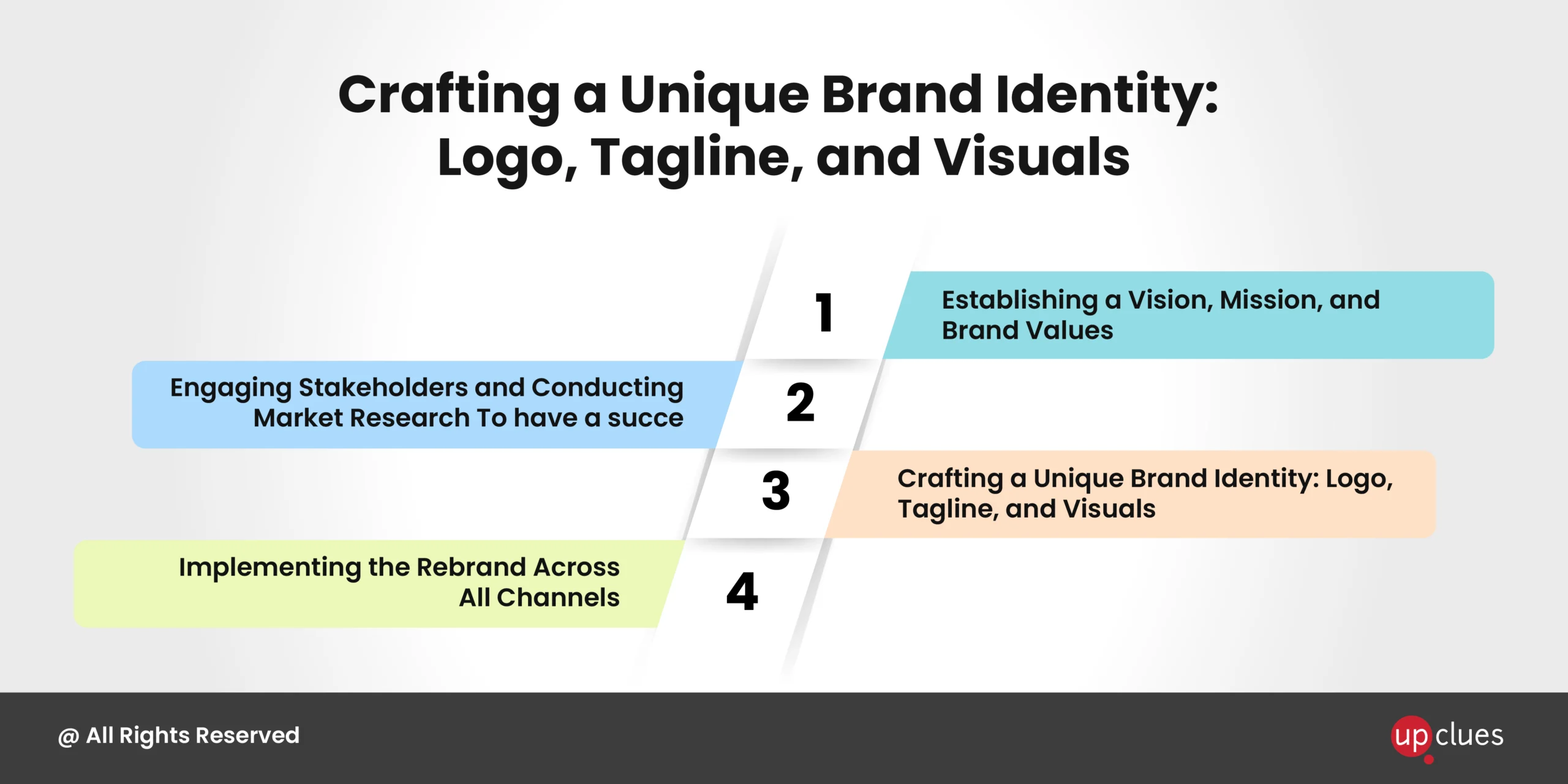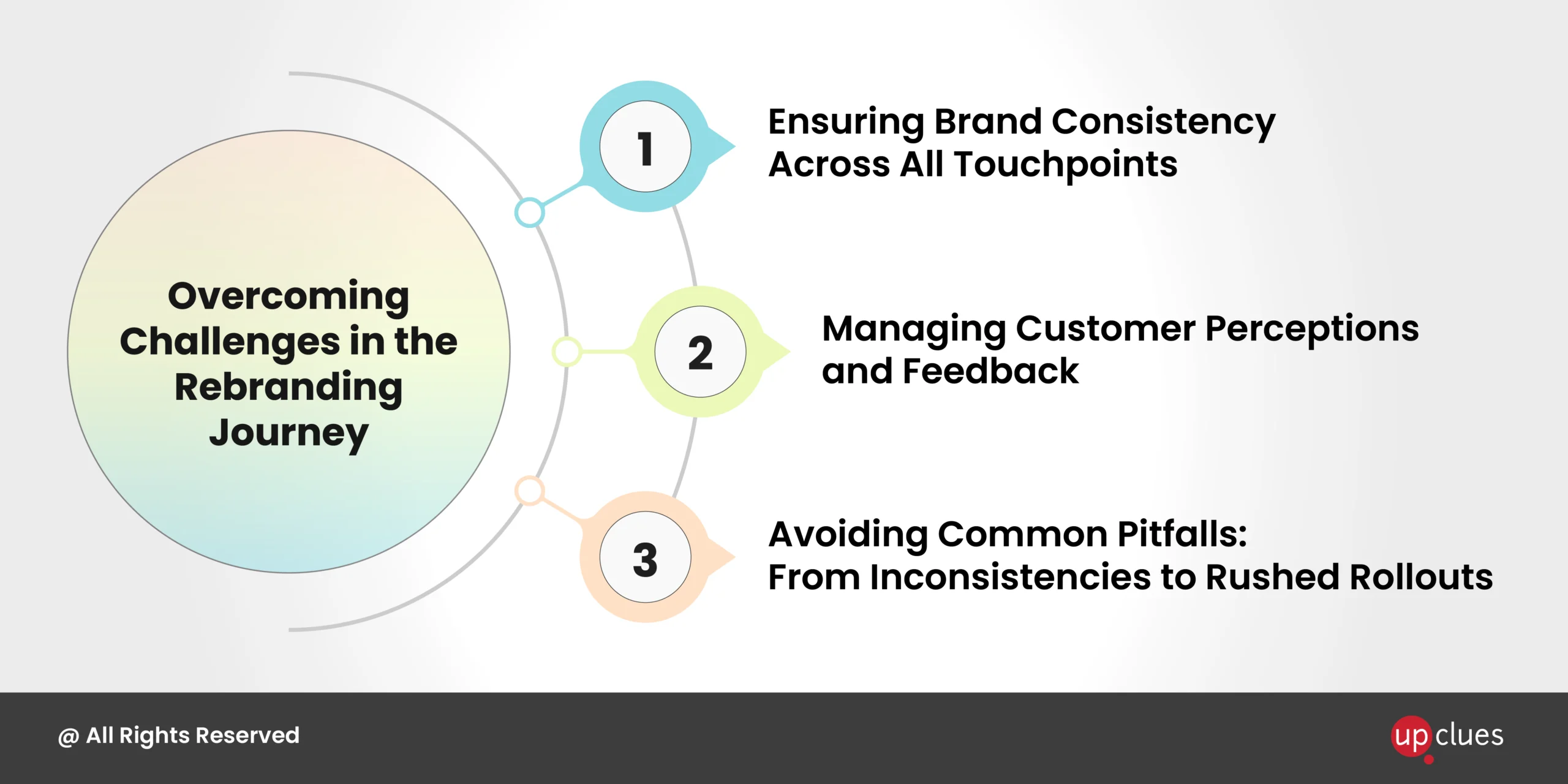
Hire Graphic Designer in 2025: Essential Skills You Need
December 26, 2024
Types of Branding
January 8, 2025
Hire Graphic Designer in 2025: Essential Skills You Need
December 26, 2024
Types of Branding
January 8, 2025What is Rebranding? Your Step-by-Step Guide
January 01, 2025
- 20 min to Read
Key Highlights
- Rebranding involves strategic changes to a company's brand identity to reflect its mission and resonate with its target audience.
- Different types of rebranding, such as refresh and overhaul, cater to varying levels of change in a brand's visual and messaging elements.
- Market dynamics and consumer expectations are key drivers behind the decision to rebrand, ensuring relevance and competitive edge.
- Knowing the right time for rebranding is crucial, with signs like evolving market trends and outdated brand identity signaling the need for change.
- The strategic process of rebranding follows steps like defining brand values, engaging stakeholders, crafting a unique brand identity, and implementing changes consistently across all channels.
- Success in rebranding efforts hinges on ensuring brand consistency, managing customer perceptions effectively, and avoiding common pitfalls like rushed rollouts and inconsistencies.
Introduction
Rebranding can change the future of a business. It brings new energy to its identity and attracts more customers. In the fast-changing market, knowing the details of rebranding is important to stay strong and compete. Refreshing visuals and adjusting brand strategy are key steps in how others see a company. This simple guide will help you understand rebranding better. You will learn how to truly connect with your target audience.

The Essence of Rebranding: A Comprehensive Overview
Rebranding means changing a brand so it fits better with what people want and how the market changes, sometimes even adopting a new name. Companies want to make their brand easy to recognize and increase brand awareness to reach more customers. This means they update their brand's look, the way they talk, and their overall plan. All these changes help create a solid brand image. To do this well, companies need to know their target audience, market trends, and what their mission is. This process takes careful planning. It looks at every part of the brand to make sure the changes are successful.
1. Defining Rebranding in the Modern Business Landscape
Rebranding today means changing a brand's identity to match what customers want and what is popular in the market. It's not just about changing logos; it is about how a company shows itself to the world. By updating their brand strategy, visuals, and the message they share, rebranding helps improve brand recognition. This can attract new customers and build brand loyalty. In today’s business world, rebranding is more than just a change in appearance. It is a smart marketing move to stay important and competitive as things change around us.
2. The Distinct Types of Rebranding: Refresh, Overhaul, and More
Rebranding has different types based on business needs. A "refresh" means making small changes to update the brand. An "overhaul" is a total change starting from the beginning. There is also a "partial rebrand," which focuses on certain parts of the brand, and a "total rebrand," which changes the whole brand identity. Each type helps companies stay relevant and connected to their audience while adjusting to market changes.

The Driving Forces Behind a Rebrand
Changes in the market and what customers expect are key reasons for companies to rebrand for various reasons. In today’s fast-changing business world, it is very important to keep up with what consumers want and what is happening in the market. Whether this change comes from mergers, acquisitions, or changes in ownership, rebranding helps companies adjust their brand identity to meet new market needs. Also, refreshing a brand that is not doing well can boost its competitiveness. In the end, knowing and responding to these reasons is crucial for rebranding to succeed.
1. Adapting to Market Changes and Consumer Expectations
In a fast-changing market, it is very important to keep up with what consumers want and how trends change. NLP, or natural language processing, helps businesses look at feelings shared on social media. It also aids in understanding brand recognition and predicting how brand image might shift. Using insights from NLP, brands can change their rebranding strategy to connect better with their target audience. This careful plan helps to align the rebrand with what consumers expect. It builds brand loyalty and helps grow the business. By focusing on the minds of consumers through NLP, companies can make smart changes to fit the changing market.
2. Navigating Through Mergers, Acquisitions, and Ownership Transitions
During mergers, acquisitions, or changes in ownership, rebranding is very important. It helps to bring together the identities of all the companies involved, including operating under an existing brand identity. This process needs to be handled carefully. It’s vital to keep the brand consistent and clearly share any changes with everyone. By combining the brand elements from all parties, we can create a cohesive brand image after the transition. This requires understanding all the brands involved and using a strong rebranding strategy. It is also crucial to pay attention to how customers see the brand and how it fits in the market during this time of change.
3. Revitalizing a Stagnant Brand to Stay Competitive
Reviving a sluggish brand and enhancing the company’s brand identity is key to staying competitive. Adding new energy and making a brand relevant, like Weight Watchers did with their rebranding, can help businesses grab the attention of consumers. It can also spark brand loyalty again. Using a smart rebranding plan that includes things like a new logo, visual identity, and brand messaging can help companies draw in new customers and reconnect with their target audience. This change not only improves brand recognition but also builds a strong brand image that fits the changing market.
Recognizing the Right Time for Rebranding
Signs that your brand needs a new path can be subtle but very important. It’s essential to consider the risks, benefits, and market changes. Changes in the market, shifts in consumer tastes, or a name change due to changes in your business focus can suggest it’s time for a new brand direction. It’s important to notice these signs quickly. Knowing when to pause on rebranding is just as important. An ill-timed rebrand can lose current customers and harm brand value. Thoughtful review and careful planning are vital to find the right time for a successful rebrand.
1. Signs Your Brand Needs a New Direction
Declining brand recognition, slow growth, or a lack of connection with your target audience are clear signs that you may need to rebrand. If your brand image does not match your values, or if customers see your brand negatively after being around for a long time, it might be time for a change. Paying attention to customer feedback, market trends, and what your competitors are doing can also show you the important role of a new approach. If you ignore these signs, you could lose your place in a competitive market. It's important to notice these indicators to stay relevant and connect with your audience.
2. Calculating the Risks: When to Hold Back on Rebranding
In the world of rebranding, being careful is very important. Knowing when to hold back and not change the brand is just as important as knowing when to go ahead. To assess the risks, you need to think about possible negative reactions, how it might affect brand loyalty, and if it matches the company's core values. You must check if the current brand identity still connects with the target audience. Also, you should ask if a rebrand will really improve the brand's place in the market. Be cautious and analyze things well to make an informed decision.

The Strategic Process of Rebranding: A Stepwise Guide
Start by creating a clear vision, mission, and brand values. These are the basics needed for a successful rebranding strategy. Talk to your stakeholders and do detailed market research. This helps you learn about your target audience’s needs. Next, make a unique brand identity. This should include a new logo, a catchy tagline, and visual elements that connect with your audience. Consider incorporating a new design to ensure freshness. Make sure you use the rebrand in the same way everywhere. This will help with a smooth change. By following these steps closely, you can handle the rebranding process confidently and set your brand up for great results.
1. Establishing a Vision, Mission, and Brand Values
Establishing a clear vision, company’s mission, and brand values are important steps in the rebranding process. A strong vision shows the brand's future direction. A good mission statement explains the purpose and goals to those involved. Defining brand values helps make decisions that match the brand's essence. This ensures consistency at every point. Together, these elements create the brand's identity. They guide important choices and shape the overall rebranding strategy. Involving key people in this process builds support and ensures everyone agrees with the brand’s new direction regarding the brand name.
2. Engaging Stakeholders and Conducting Market Research
To have a successful rebranding, it is very important to engage stakeholders and do thorough market research. Involving key people inside and outside the business helps connect the rebranding efforts with the brand's identity and values. Market research gives useful information about what consumers prefer and what is happening in the industry. This helps guide the rebranding direction. By bringing in stakeholders early and doing good market research, companies can make smart choices that appeal to their target audience. This leads to a more effective rebranding strategy.
3. Crafting a Unique Brand Identity: Logo, Tagline, and Visuals
Creating a unique brand identity is more than just designing a new company logo. It requires a strong combination of your logo, tagline, and visuals that appeal to your target audience. A great tagline shows the heart of your brand. Also, attractive graphics and a cohesive color palette communicate a lot about who you are as a brand. Together, these elements create the visual identity that sticks in the minds of consumers. It is important to keep everything consistent across all your branding materials. This is key for building a strong and memorable brand image. Your branding story isn't complete if you don't pay attention to these visual elements.
4. Implementing the Rebrand Across All Channels
To have a successful rebranding, it's important to use a well-rounded marketing strategy plan. You need to change your brand across all channels due to this big change. This includes social media, website design, email marketing, and any marketing materials. Doing this helps your brand image stay the same everywhere. A clear and cohesive brand image will connect well with your target audience while also keeping your brand recognition strong.
Using similar visual elements and a steady brand voice will help build brand loyalty. It also supports your rebranding efforts in a good way. When you carefully manage these changes at all levels, it ensures a good idea for a smooth rebranding journey. It's essential for a new brand identity to make a positive impact on your audience.

Overcoming Challenges in the Rebranding Journey
Ensuring the brand image is the same at every point is a big challenge when rebranding. It takes care and flexibility to handle what customers think and say. To steer clear of common mistakes, such as inconsistencies and quick launches, careful planning is a must. It's important to build a cohesive brand image during changes. Always sharing the new identity with your audience is key. Keeping brand loyalty while making changes is also a tricky job. Handling these challenges well helps create a smooth rebranding process.
1. Ensuring Brand Consistency Across All Touchpoints
Consistency is very important when rebranding. It helps keep the brand's trust and integrity intact. It is vital to have a uniform look across all areas, such as social media, marketing materials, and customer service. This helps create a strong brand image. When a business aligns its brand identity, messages, and visual elements, it builds brand recognition and loyalty.
Clear communication connects with the target audience and strengthens the brand's presence. A consistent approach improves brand recall and engagement. This leaves a good impression on consumers. For a successful rebranding effort, it is crucial to strive for consistency across all platforms.
2. Managing Customer Perceptions and Feedback
Understanding what customers think is very important during rebranding. You should communicate clearly and listen to their concerns. Addressing feedback in a good way is key. By talking to customers through social media and focus groups, you can make sure their voices are heard. It’s also important to watch their feedback closely. This way, you can make quick changes and keep the customer experience positive during the rebranding process. Showing customers that their opinions matter can build their trust and loyalty.
3. Avoiding Common Pitfalls: From Inconsistencies to Rushed Rollouts
In the world of rebranding, avoiding common mistakes is very important. Issues like mixed messages and rushed launches can upset the entire process of rebranding. Keeping a clear and consistent brand presence is necessary to connect well with customers and make a positive first impression. It is also important to handle customer feedback quickly and carefully to protect the brand’s image during changes. By avoiding these mistakes, brands can go through the rebranding process smoothly and come out stronger and better focused on their goals.
Celebrated Successes and Teachable Failures in Rebranding
Analyzing successful rebranding campaigns in India shows useful strategies that connect with the target audience. Iconic brands like Victoria’s Secret highlight this well. Learning from rebranding mistakes is also important. It reminds us of how careful we need to be in the rebranding process. By looking at both successes and failures, businesses can learn helpful lessons for their own rebranding journey. Celebrating successes and recognizing failures helps us understand the detailed work of changing a brand's identity.
Analyzing Successful Rebranding Campaigns in India
Analyzing successful rebranding campaigns in India shows useful strategies that connect with the target audience. Iconic brands like Victoria’s Secret highlight this well. Learning from rebranding mistakes is also important. It reminds us of how careful we need to be in the rebranding process. By looking at both successes and failures, businesses can learn helpful lessons for their own rebranding journey. Celebrating successes and recognizing failures helps us understand the detailed work of changing a brand's identity.
Conclusion
In conclusion, rebranding is about changing a brand’s identity to fit the changing market and what customers want. By updating things like logos, messages, and values, companies can improve their image and attract new customers while keeping current ones, ultimately driving business growth. Successful rebranding needs a clear plan, good market research, and steady action in all areas. It is important to listen to customer feedback, adjust to industry trends, and stay flexible for a rebranding effort to succeed in the long run.
Revitalize your brand with Upclues, a premier creative agency in ahmedabad. Specializing in creating impactful brand transformations, we help businesses connect with their audience, boost recognition, and achieve a competitive advantage. Let us craft a strategy that’s uniquely yours!
Frequently Asked Questions
1. What are the first steps in initiating a rebrand?
- To start a rebrand, first do a complete brand check. This will help you see how people view your brand right now.
- Next, set clear goals and targets for the rebrand.
- Involve key people early. Their ideas and support can really help.
2. How do you measure the success of a rebranding effort?
Success can be measured by looking at changes in how people see the brand, how customers engage, and growth in revenue after a rebrand. It is also important to track changes in market share and how competitors react. These factors help in understanding if the rebrand is effective.






